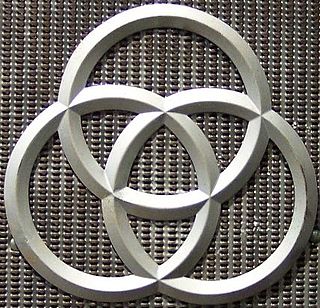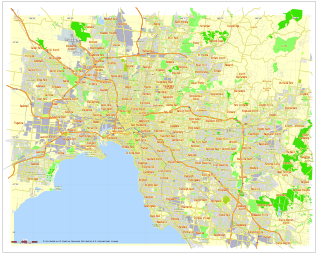
The British Rail (BR) Class 08 is a class of diesel-electric shunting locomotive. The pioneer locomotive, number 13000, was built in 1952 although it did not enter service until 1953. Production continued until 1962; 996 locomotives were produced, making it the most numerous of all British locomotive classes.

The Hunslet Engine Company was founded in 1864 in Hunslet, Leeds, England. The company manufactured steam-powered shunting locomotives for over 100 years, and currently manufactures diesel-engined shunting locomotives.

Rail transport in Victoria, Australia, is provided by a number of railway operators who operate over the government-owned railway lines. The network consists of Victorian broad gauge lines, and an increasing number of standard gauge freight and interstate lines; the latter brought into existence as a result of gauge conversion of the former. Historically, a few experimental 762 mm gauge lines were built, along with various private logging, mining and industrial railways.
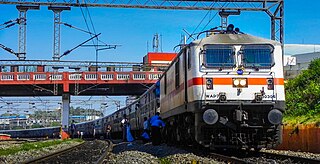
The Indian Railways primarily operates electric and diesel locomotives. Steam locomotives are operated on a few World Heritage sites and also run occasionally as heritage trains. A locomotive is also known as a loco or engine. The country's first steam locomotive ran on the Red Hill Railway from Red Hills to the Chintadripet bridge in Madras in 1837.

The F Class were a class of diesel locomotive shunters built by Dick Kerr Works for the Victorian Railways between 1951 and 1953. They are similar to the British Rail Class 11 and NS Class 600 shunting locomotives also built by English Electric during this period, but modified for use on the VR's 5 ft 3 in (1,600 mm) broad gauge.
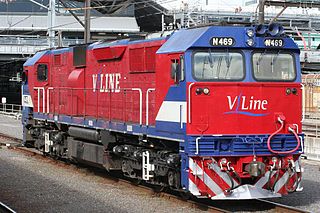
The N Class are a class of diesel locomotives built by Clyde Engineering, Somerton for V/Line between 1985 and 1987.

The T class are a class of diesel locomotives built by Clyde Engineering, Granville for the Victorian Railways between 1955 and 1968.

The GM class are a class of diesel locomotives built by Clyde Engineering, Granville for the Commonwealth Railways in several batches between 1951 and 1967. As at January 2014 some remain in service with Genesee & Wyoming Australia and Southern Shorthaul Railroad.

The X100 class were a group of rail tractors built by Chullora Railway Workshops in 1962 and operated by the New South Wales Government Railways of Australia.

The 73 class are a diesel-hydraulic locomotive built by Walkers Limited, Maryborough for the New South Wales Government Railways between 1970 and 1973.

This page contains a list of jargon used to varying degrees by railfans, trainspotters, and railway employees in Australia, including nicknames for various locomotives and multiple units. Although not exhaustive, many of the entries in this list appear from time to time in specialist, rail-related publications. There may be significant regional variation in usage; state variances may be indicated by the state abbreviation.

The W class are a diesel-hydraulic shunting locomotive ordered and operated by the Victorian Railways of Australia. In 2006 locomotive W241 was used to haul the 4D train to the scrapyard, with W241 and W244 also operated in revenue service by El Zorro on works trains.
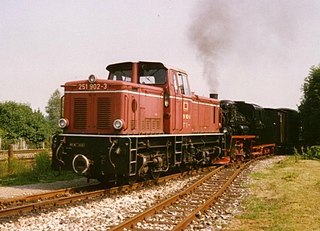
The DB Class V 51 and DB Class V 52 are classes of almost identical narrow gauge 4 axle diesel hydraulic locomotives built in 1964 for the Deutsche Bundesbahn, being built for 750 mm and 1,000 mm gauge lines respectively.
The Rolls-RoyceC range was a series of in-line 4, 6 and 8 cylinder diesel engines used in small railway locomotives, construction vehicles, marine and similar applications. They were manufactured by the Rolls-Royce Oil Engine Division, initially at Derby and later at Shrewsbury, from the 1950s through to 1970s.
The Union of South Africa was established on 31 May 1910 in terms of the South Africa Act, which unified the former Cape Colony, Natal Colony and the two colonised former republics, the Transvaal and the Orange Free State. One of the clauses in the Act required that the three Colonial Government railways, the Cape Government Railways, the Natal Government Railways and the Central South African Railways, also be united under one single administration to control and administer the railways, ports and harbours of the Union. While the South African Railways (SAR) came into existence in 1910, the actual classification and renumbering of all the rolling stock of the three constituent railways required careful planning and was only implemented with effect from 1 January 1912.

The DH class was a class of diesel-hydraulic locomotives built by Walkers Limited, Maryborough for Queensland Railways between 1966 and 1974.
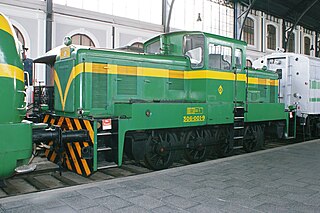
The Yorkshire Engine Company Taurus and Indus locomotives were two very similar lines of 0-8-0, diesel-hydraulic locomotives that weighed 58 tons and had a maximum speed of 36 mph (58 km/h). The two Rolls-Royce C8SFL diesel engines gave a total of 600 hp (450 kW). The transmission of the Taurus locomotives worked on a similar principle to that of the Fell diesel tested during the early 1950s. In this case, at low speeds only one engine was used, the second being engaged between 3.5 mph and 15 mph to enable haulage of 300 - 500 ton loads at speeds of up to 36 mph. The maximum speed with one engine was 12 mph (19 km/h) while the minimum speed with both engines was 3.5 mph (5.6 km/h). Both engines drove to a common torque converter and used a common throttle control with a separate lever being provided to engage the second engine as the need arose.

